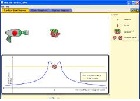
login - create an account - help

published by
the PhET
written by Mark Blaisdell
This student hand-out was created specifically to accompany the PhET simulation "Nuclear Fission". Appropriate for grades 8-12, it provides guided directions on using the simulation to ensure that students stay focused on learning goals. The simulation features a neutron gun that "fires" an accelerated neutron into a Uranium-235 nucleus. By using this printed guide, students will be prompted to think about what happens in a nuclear reaction, what makes a nucleus "fissionable" and how nuclear power containment vessels prevent a runaway chain reaction.
The fission simulation, which must be open and displayed to complete this activity, is available from PhET at: Nuclear Fission. This lesson is part of PhET (Physics Education Technology Project), a large collection of free interactive simulations for science education.
AAAS Benchmark Alignments (2008 Version)3. The Nature of Technology
3C. Issues in Technology
4. The Physical Setting
4D. The Structure of Matter
11. Common Themes
11B. Models
11D. Scale
Common Core State Standards for Mathematics AlignmentsHigh School — Functions (9-12)
Linear, Quadratic, and Exponential Models? (9-12)
ComPADRE is beta testing Citation Styles!
<a href="https://www.compadre.org/portal/items/detail.cfm?ID=11332">Blaisdell, Mark. PhET Teacher Activities: Nuclear Fission Simulation - Student Guide. Boulder: PhET, July 8, 2009.</a>
M. Blaisdell, (PhET, Boulder, 2009), WWW Document, (https://phet.colorado.edu/en/activities/3249).
M. Blaisdell, PhET Teacher Activities: Nuclear Fission Simulation - Student Guide (PhET, Boulder, 2009), <https://phet.colorado.edu/en/activities/3249>.
Blaisdell, M. (2009, July 8). PhET Teacher Activities: Nuclear Fission Simulation - Student Guide. Retrieved May 1, 2025, from PhET: https://phet.colorado.edu/en/activities/3249
Blaisdell, Mark. PhET Teacher Activities: Nuclear Fission Simulation - Student Guide. Boulder: PhET, July 8, 2009. https://phet.colorado.edu/en/activities/3249 (accessed 1 May 2025).
Blaisdell, Mark. PhET Teacher Activities: Nuclear Fission Simulation - Student Guide. Boulder: PhET, 2009. 8 July 2009. 1 May 2025 <https://phet.colorado.edu/en/activities/3249>.
@misc{
Author = "Mark Blaisdell",
Title = {PhET Teacher Activities: Nuclear Fission Simulation - Student Guide},
Publisher = {PhET},
Volume = {2025},
Number = {1 May 2025},
Month = {July 8, 2009},
Year = {2009}
}
%A Mark Blaisdell %T PhET Teacher Activities: Nuclear Fission Simulation - Student Guide %D July 8, 2009 %I PhET %C Boulder %U https://phet.colorado.edu/en/activities/3249 %O application/ms-word %0 Electronic Source %A Blaisdell, Mark %D July 8, 2009 %T PhET Teacher Activities: Nuclear Fission Simulation - Student Guide %I PhET %V 2025 %N 1 May 2025 %8 July 8, 2009 %9 application/ms-word %U https://phet.colorado.edu/en/activities/3249 Disclaimer: ComPADRE offers citation styles as a guide only. We cannot offer interpretations about citations as this is an automated procedure. Please refer to the style manuals in the Citation Source Information area for clarifications.
Citation Source Information
The AIP Style presented is based on information from the AIP Style Manual. The APA Style presented is based on information from APA Style.org: Electronic References. The Chicago Style presented is based on information from Examples of Chicago-Style Documentation. The MLA Style presented is based on information from the MLA FAQ. This resource is stored in a shared folder. You must login to access shared folders. PhET Teacher Activities: Nuclear Fission Simulation - Student Guide:
Requires
PhET Simulation: Nuclear Fission
A link to the PhET simulation "Nuclear Fission", which this student guide was specifically created to supplement. relation by Caroline Hall
Same topic as
PhET Teacher Activities: Modeling Isotopes
An editor-recommended lesson to guide beginners in modeling atoms and their variant isotopes. It goes with the PhET simulation Isotopes and Atomic Mass. relation by Caroline Hall
Same topic as
PhET Teacher Activities: Alpha Decay Investigations
A lesson plan that accompanies the PhET simulation Alpha Decay, intended for AP and algebra-based physics students with prior exposure to half-life and fundamental understanding of nuclear decay. relation by Caroline HallKnow of another related resource? Login to relate this resource to it. |
SupplementsContributeRelated Materials
Requires
PhET Simulation: Nuclear Fission Same topic asPhET Teacher Activities: Modeling Isotopes Same topic asSimilar Materials |